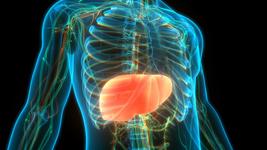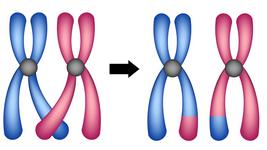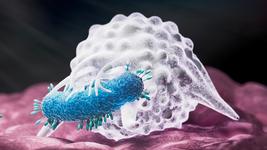CMN Weekly (9 February 2024) - Your Weekly CRISPR Medicine News
By: Gorm Palmgren - Feb. 9, 2024
Top picks
- CRISPR-Cas9-mediated deletion of ICAM-1, implicated in neuroinflammation and cognitive deficits post-traumatic brain injury (TBI), shows promise in reducing leukocyte brain transmigration and blood-brain barrier damage. This intervention targets the paxillin/FAK-dependent Rho GTPase pathway, which is pivotal in leukocyte adhesion and transmigration. Behavioural tests post-TBI in treated mice reveal potential in ICAM-1 blockage as a novel preventive strategy against TBI pathophysiology, highlighting the therapeutic value of targeting ICAM-1 in neuroinflammatory conditions.
- CRISPR-guided gene modulation has been employed to direct the differentiation of adipose-derived stem cells (ASCs), showcasing its potential in engineering complex tissue gradients. By targeting osteogenic inhibitors with CRISPRi, notably NOG, the study demonstrates controlled osteogenic differentiation and mineral deposition in ASCs without exogenous factors. Combining CRISPR activation with multiplex engineering and high-density collagen constructs, a cell and tissue gradient mimicking native fibrocartilage transitions was created. This approach highlights the capability of CRISPR-engineered ASCs to replicate intricate tissue structures.
Research
- Dutch researchers demonstrate that lipid nanoparticles (LNPs) deliver mRNA Cas9, sgRNA, and HDR templates better than Cas9-RNP and HDR templates. The mRNA Cas9 LNPs demonstrated smaller sizes, enhanced enzyme protection, and higher editing efficiency in vitro.
- A study employing CRISPR-Cas9 screening has uncovered that multiple myeloma (MM) cells develop resistance to DNA-damaging therapies by metabolically adapting to maintain energy balance. The research highlights the role of the mitochondrial DNA repair protein DNA2, which is crucial for MM cells to counteract the effects of therapies targeting the DNA damage regulator ILF2. Inhibiting DNA2 could expose a vulnerability in MM cells, particularly those reliant on heightened mitochondrial metabolism following DNA damage.
- Canadian researchers have developed a CRISPR base editing model to explore telomere biology disorder (TBD) genes, aiming better to understand their roles in human health and aging. In the study, 21 telomere-related genes were mutagenised, leading to the identification of critical residues in the genes encoding 17 different proteins impacting cell growth. Moreover, the researchers identified variants resistant to telomerase inhibition that exhibited increased tumorigenic potential using an in vitro tumour growth assay.
- Italian researchers have developed a CRISPR-Cas9 HDR-mediated approach for integrating a corrective sequence into the human RAG1, in which mutations can cause severe combined immunodeficiency (SCID). In-frame insertion into exon 2 drove physiologic human RAG1 expression and activity in HSPCs from patients with high gene correction efficiency. When these cells were xenotransplanted into immunodeficient Rag1-/- mice, they led to improved B cell production and overcame the T cell differentiation block.
- American researchers have demonstrated highly efficient prime editing of mouse embryos using transient inhibition of DNA mismatch repair during a permissive stage of development. Whole-genome sequencing revealed that mismatch repair inhibition led to an average of 58% precise edit frequency with only 0.5% on-target error frequency across 13 substitution edits at eight sites.
- German researchers have used an ex vivo AAV-based CRISPR-Cas9 system to repair mutations in potentially long-lived T cells that can cause familial hemophagocytic lymphohistiocytosis (FHL), an often fatal, inherited immune deficiency. Gene editing was performed with an inhibitor of nonhomologous end joining, and the repaired CD8 memory T cells efficiently cured lethal hyperinflammation in a mouse model of Epstein-Barr virus-triggered FHL2.
- Spanish researchers have developed MACHETE, a CRISPR-Cas9-based system, to delete large genomic regions efficiently, overcoming previous limitations in cell engineering. By inserting a selection cassette and then guiding CRISPR to remove it along with the target region, MACHETE enriches for cells with the desired deletion. This method has enabled deletions up to 45 Mb, offering new possibilities in studying cancer genetics, transcriptional regulation, and genome structure.
Industry
- The Bespoke Gene Therapy Consortium has published its initial regulatory playbook, accelerating patient access to cutting-edge gene therapies for rare diseases. Many patients with rare diseases have no other hope, and this is a significant step along the path to rare disease drug development, particularly for smaller biotech companies and startups.
- Vertex Pharmaceuticals has reported financial results for 2023. The year ended with a product revenue of $9.87 billion and $13.7 billion in cash.
Detection
- Researchers in China have engineered CRISPR-Cas12b and Cas13a to significantly improve their performance in pathogen detection, making them competitive for on-site and in-home diagnostics. Engineered Cas12b demonstrated a 10-10,000-fold increase in sensitivity, accurately detecting SARS-CoV-2 in clinical samples. Similarly, optimised Cas13a assays showed high accuracy and sensitivity under relaxed conditions, promising rapid and reliable testing. These advancements overcome previous limitations, positioning CRISPR-based diagnostics as a viable option for widespread pathogen detection.
- A novel one-pot genotyping assay for detecting SARS-CoV-2 Omicron sub-lineages has been developed by integrating a photoactivated CRISPR-Cas12a strategy with recombinase polymerase amplification (RPA). The detection can be finished in one tube at 39℃ within one hour and exhibits a low detection limit of 30 copies per reaction.
- Chinese researchers present a novel DNA methylation detection method (meHOLMES), which integrates the TET2/APOBEC-mediated (unmethylated) cytosine deamination step and the CRISPR-Cas12a-based signal readout step. meHOLMES quantitatively detects methylated CpG sites within 6 hours, much faster than the traditional bisulfite-based sample pre-treatment method.
- Scientists in China present a novel one-pot Cas12b-based method coupled with the "Green-Yellow-Red" strategy for multiplex detection. By integrating RT-LAMP amplification and Cas12b cleavage in a single tube, the entire detection process can be completed within one hour with high specificity, enabling the discrimination of single-base mutations with detection sensitivity approaching single molecule levels.
CRISPR screens
- CRISPR screens have pinpointed ITGAV (integrin αV) and ITGB5 (integrin β5) as key for cancer cell growth, revealing a critical dimerisation site within ITGAV. Using this insight, the CRISPR-TICA pipeline identified Cpd_AV2, a compound disrupting integrin αVβ5, leading to cancer cell apoptosis. This approach offers a new path for targeted cancer therapy.
- British scientists have developed a new CRISPRi-based single-cell functional screening approach in primary human T cells that can identify genes and molecular programs modulated by regulatory elements. The scalable, single-cell functional genomics approach - primary T cell crisprQTL - is shown to facilitate the interrogation of immune disease GWAS hits.
- A whole-genome CRISPR loss-of-function screen has revealed temporal inherent and acquired responses to radiation therapy (RT) in cancer cells. The results suggest combining an apoptosis inhibitor such as a BCL2L1 inhibitor with RT may represent a promising anticancer strategy for solid cancers including breast cancer.
Reviews
- CRISPR technologies for genome, epigenome and transcriptome editing. This review highlights the strengths and weaknesses of current CRISPR tools, considering their efficiency, precision, specificity, reliance on cellular DNA repair mechanisms and their applications in both fundamental biology and therapeutics.
- New Perspectives in Stem Cell Transplantation and Associated Therapies to Treat Retinal Diseases: From Gene Editing to 3D Bioprinting. This review describes the recent advances in the field by presenting an updated panel based on cell transplants and related therapies to treat retinopathies.
- Therapeutic Potential of CRISPR/Cas in Hashimoto's Thyroiditis: A Comprehensive Review. This review highlights the potential candidate genes associated with Hashimoto's thyroiditis and the few animal and human models generated via the CRISPR-Cas gene editing technique. Hashimoto's thyroiditis is a commonly occurring illness of autoimmune endocrine origin.
News from CRISPR Medicine News
- Monday, we brought a transcript of our first CMN Live event broadcast last Friday. Our editor-in-chief, Karen O'Hanlon Cohrt, spoke with Dr Eric Kmiec, the Scientific Director at the ChristianaCare Gene Editing Institute in Delaware and Chief Scientific Officer at CorriXR Therapeutics. They discussed the successes of therapeutic gene editing to date and the challenges that lie ahead. You can watch the interview on LinkedIn here.
To get more of the CRISPR Medicine News delivered to your inbox, sign up to the free weekly CMN Newsletter here.
Tags
CLINICAL TRIALS
IND Enabling
Phase I
Phase II
Phase III
Gastric Cancer and Colorectal Cancer, CRC, (NCT07166263)
Sponsors:
Base Therapeutics (Shanghai) Co., Ltd.
Sponsors:
Base Therapeutics (Shanghai) Co., Ltd.
IND Enabling
Phase I
Phase II
Phase III
Relapsed or Refractory Acute Myeloid Leukemia, AML, (NCT06541444)
Sponsors:
Base Therapeutics (Shanghai) Co., Ltd.
Sponsors:
Base Therapeutics (Shanghai) Co., Ltd.
IND Enabling
Phase I
Phase II
Phase III







